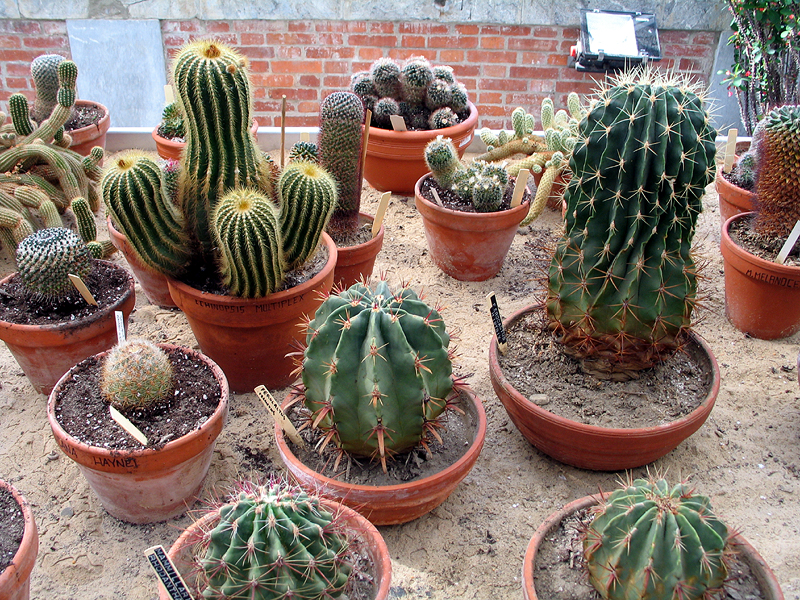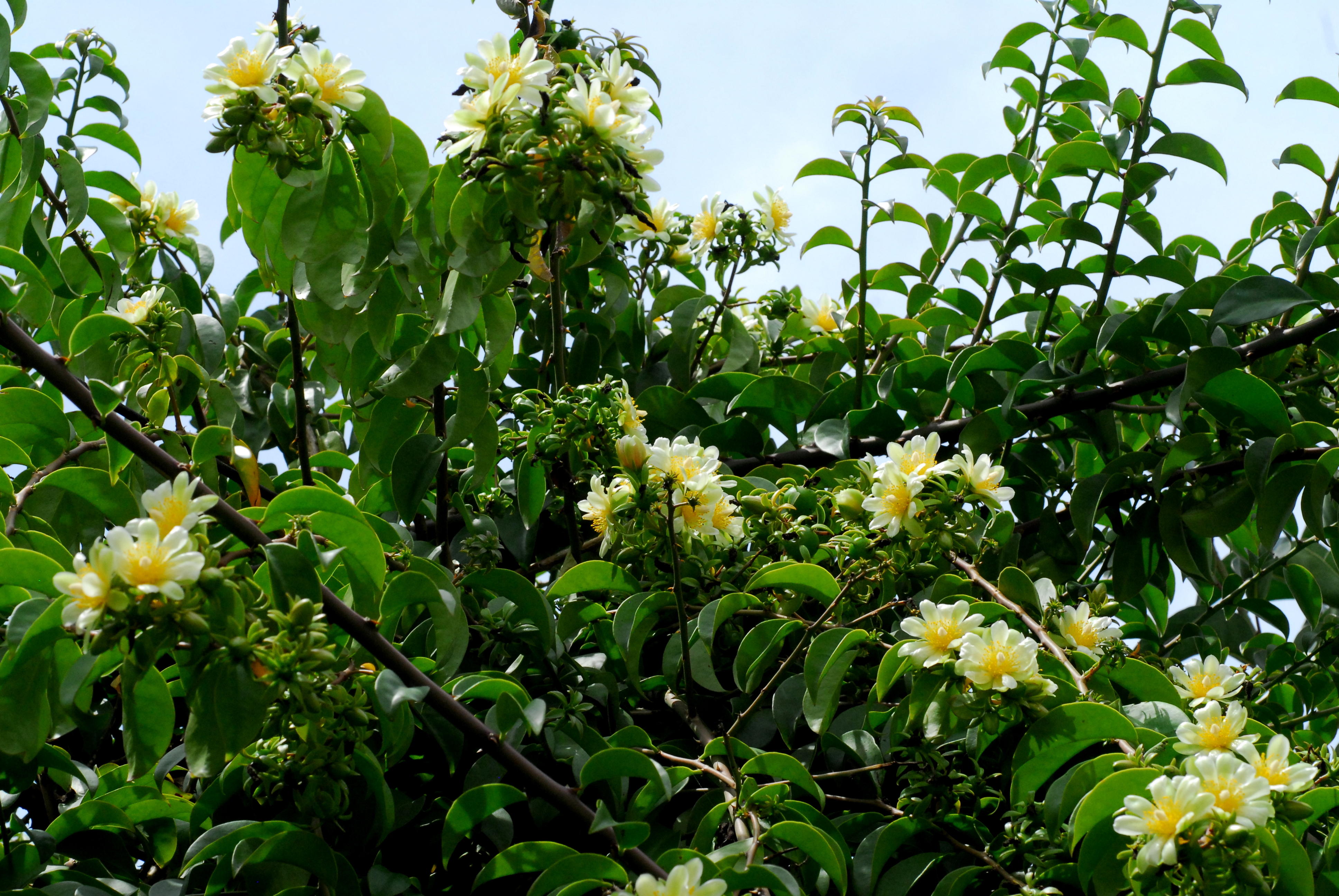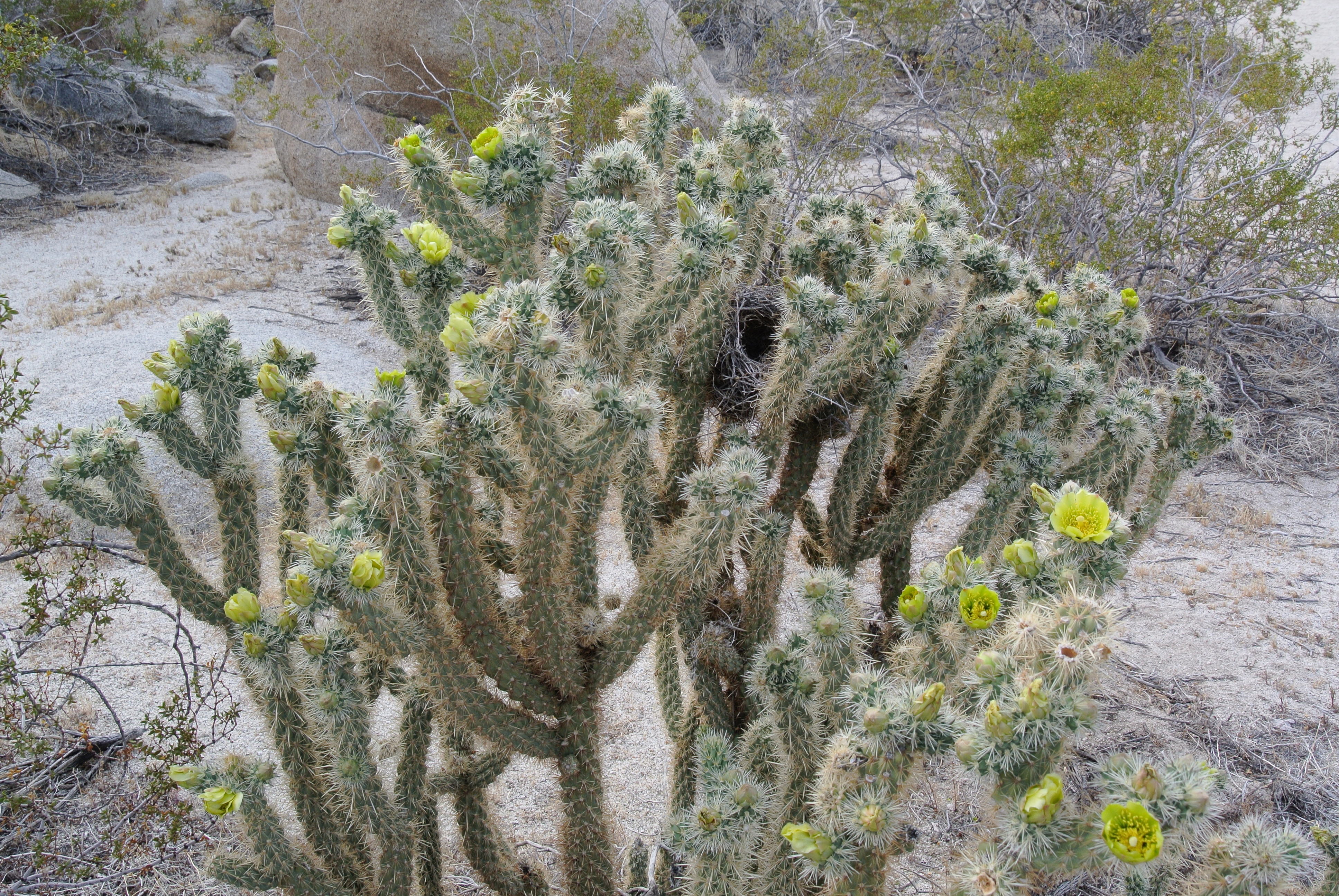|
Opuntieae
Opuntioideae is a subfamily of the cactus family, Cactaceae. It contains 15 genera divided into five tribes. The subfamily encompasses roughly 220–250 species, and is geographically distributed throughout the New World from Canada, to Argentina. Members of this subfamily have diverse habits, including small geophytes, hemispherical cushions, shrubs, trees, and columnar cacti consisting of indeterminate branches or determinate terete or spherical segments. Description Synapomorphies of Opuntioideae include small deciduous, barbed spines called glochids born on areoles and a bony aril surrounding a campylotropous ovule (inverted and curved, such that the micropyle almost meets the funiculus). Other prominent morphological characters for this subfamily are presence of cylindrical, caducous leaves that tend to be shed by maturity and the sectioning of the stem into joints or pads known as cladodes. Opuntioideae are unique among cacti for lacking in the stem a thick cortex, an exte ... [...More Info...] [...Related Items...] OR: [Wikipedia] [Google] [Baidu] |
Austrocylindropuntieae
In 1984, the International Organization for Succulent Plant Study set up a working party, now called the International Cactaceae Systematics Group, to produce a consensus classification of the cactus family, down to the level of genus. Their classification has been used as the basis for systems published since the mid-1990s. Treatments in the 21st century have generally divided the family into around 125–130 genera and 1,400–1,500 species, which are then arranged in a number of tribes and subfamilies. However, subsequent molecular phylogenetic studies have shown that a very high proportion of the higher taxa (genera, tribes and subfamilies) are not monophyletic, i.e. they do not contain all of the descendants of a common ancestor. , the internal classification of the family Cactaceae remained uncertain and subject to change. A classification incorporating many of the insights from the molecular studies was produced by Nyffeler and Eggli in 2010. Overview The classification ... [...More Info...] [...Related Items...] OR: [Wikipedia] [Google] [Baidu] |
Cylindropuntieae
In 1984, the International Organization for Succulent Plant Study set up a working party, now called the International Cactaceae Systematics Group, to produce a consensus classification of the cactus family, down to the level of genus. Their classification has been used as the basis for systems published since the mid-1990s. Treatments in the 21st century have generally divided the family into around 125–130 genera and 1,400–1,500 species, which are then arranged in a number of tribes and subfamilies. However, subsequent molecular phylogenetic studies have shown that a very high proportion of the higher taxa (genera, tribes and subfamilies) are not monophyletic, i.e. they do not contain all of the descendants of a common ancestor. , the internal classification of the family Cactaceae remained uncertain and subject to change. A classification incorporating many of the insights from the molecular studies was produced by Nyffeler and Eggli in 2010. Overview The classification ... [...More Info...] [...Related Items...] OR: [Wikipedia] [Google] [Baidu] |
Tephrocacteae
In 1984, the International Organization for Succulent Plant Study set up a working party, now called the International Cactaceae Systematics Group, to produce a consensus classification of the cactus family, down to the level of genus. Their classification has been used as the basis for systems published since the mid-1990s. Treatments in the 21st century have generally divided the family into around 125–130 genera and 1,400–1,500 species, which are then arranged in a number of tribes and subfamilies. However, subsequent molecular phylogenetic studies have shown that a very high proportion of the higher taxa (genera, tribes and subfamilies) are not monophyletic, i.e. they do not contain all of the descendants of a common ancestor. , the internal classification of the family Cactaceae remained uncertain and subject to change. A classification incorporating many of the insights from the molecular studies was produced by Nyffeler and Eggli in 2010. Overview The classification ... [...More Info...] [...Related Items...] OR: [Wikipedia] [Google] [Baidu] |
Opuntieae
Opuntioideae is a subfamily of the cactus family, Cactaceae. It contains 15 genera divided into five tribes. The subfamily encompasses roughly 220–250 species, and is geographically distributed throughout the New World from Canada, to Argentina. Members of this subfamily have diverse habits, including small geophytes, hemispherical cushions, shrubs, trees, and columnar cacti consisting of indeterminate branches or determinate terete or spherical segments. Description Synapomorphies of Opuntioideae include small deciduous, barbed spines called glochids born on areoles and a bony aril surrounding a campylotropous ovule (inverted and curved, such that the micropyle almost meets the funiculus). Other prominent morphological characters for this subfamily are presence of cylindrical, caducous leaves that tend to be shed by maturity and the sectioning of the stem into joints or pads known as cladodes. Opuntioideae are unique among cacti for lacking in the stem a thick cortex, an exte ... [...More Info...] [...Related Items...] OR: [Wikipedia] [Google] [Baidu] |
Cladode
Phylloclades and cladodes are flattened, photosynthetic shoots, which are usually considered to be modified branches. The two terms are used either differently or interchangeably by different authors. ''Phyllocladus'', a genus of conifer, is named after these structures. Phylloclades/cladodes have been identified in fossils dating from as early as the Permian. Definition and morphology The term "phylloclade" is from the New Latin ''phyllocladium'', itself derived from Greek ''phyllo'', leaf, and ''klados'', branch. Definitions of the terms "phylloclade" and "cladode" vary. All agree that they are flattened structures that are photosynthetic and resemble leaf-like branches. In one definition, phylloclades are a subset of cladodes, namely those that greatly resemble or perform the function of leaves, as in Butcher's broom (''Ruscus aculeatus'') as well as ''Phyllanthus'' and some ''Asparagus'' species. By an alternative definition, cladodes are distinguished by their limited gr ... [...More Info...] [...Related Items...] OR: [Wikipedia] [Google] [Baidu] |
Ovule
In seed plants, the ovule is the structure that gives rise to and contains the female reproductive cells. It consists of three parts: the ''integument'', forming its outer layer, the ''nucellus'' (or remnant of the megasporangium), and the female gametophyte (formed from a haploid megaspore) in its center. The female gametophyte — specifically termed a ''megagametophyte''— is also called the ''embryo sac'' in angiosperms. The megagametophyte produces an egg cell for the purpose of fertilization. The ovule is a small structure present in the ovary. It is attached to the placenta by a stalk called a funicle. The funicle provides nourishment to the ovule. Location within the plant In flowering plants, the ovule is located inside the portion of the flower called the gynoecium. The ovary of the gynoecium produces one or more ovules and ultimately becomes the fruit wall. Ovules are attached to the placenta in the ovary through a stalk-like structure known as a ''funiculus'' ... [...More Info...] [...Related Items...] OR: [Wikipedia] [Google] [Baidu] |
Micropyle (botany)
In seed plants, the ovule is the structure that gives rise to and contains the female reproductive cells. It consists of three parts: the ''integument'', forming its outer layer, the ''nucellus'' (or remnant of the megasporangium), and the female gametophyte (formed from a haploid megaspore) in its center. The female gametophyte — specifically termed a ''megagametophyte''— is also called the ''embryo sac'' in angiosperms. The megagametophyte produces an egg cell for the purpose of fertilization. The ovule is a small structure present in the ovary. It is attached to the placenta by a stalk called a funicle. The funicle provides nourishment to the ovule. Location within the plant In flowering plants, the ovule is located inside the portion of the flower called the gynoecium. The ovary of the gynoecium produces one or more ovules and ultimately becomes the fruit wall. Ovules are attached to the placenta in the ovary through a stalk-like structure known as a ''funiculus'' (p ... [...More Info...] [...Related Items...] OR: [Wikipedia] [Google] [Baidu] |
Funiculus (plant Reproduction)
In seed plants, the ovule is the structure that gives rise to and contains the female reproductive cells. It consists of three parts: the ''integument'', forming its outer layer, the ''nucellus'' (or remnant of the megasporangium), and the female gametophyte (formed from a haploid megaspore) in its center. The female gametophyte — specifically termed a ''megagametophyte''— is also called the ''embryo sac'' in angiosperms. The megagametophyte produces an egg cell for the purpose of fertilization. The ovule is a small structure present in the ovary. It is attached to the placenta by a stalk called a funicle. The funicle provides nourishment to the ovule. Location within the plant In flowering plants, the ovule is located inside the portion of the flower called the gynoecium. The ovary of the gynoecium produces one or more ovules and ultimately becomes the fruit wall. Ovules are attached to the placenta in the ovary through a stalk-like structure known as a ''funiculus'' (p ... [...More Info...] [...Related Items...] OR: [Wikipedia] [Google] [Baidu] |
Caducous
Dehiscence is the splitting of a mature plant structure along a built-in line of weakness to release its contents. This is common among fruits, anthers and sporangia. Sometimes this involves the complete detachment of a part; structures that open in this way are said to be dehiscent. Structures that do not open in this way are called indehiscent, and rely on other mechanisms such as decay or predation to release the contents. A similar process to dehiscence occurs in some flower buds (e.g., ''Platycodon'', ''Fuchsia''), but this is rarely referred to as dehiscence unless circumscissile dehiscence is involved; anthesis is the usual term for the opening of flowers. Dehiscence may or may not involve the loss of a structure through the process of abscission. The lost structures are said to be caducous. Association with crop breeding Manipulation of dehiscence can improve crop yield since a trait that causes seed dispersal is a disadvantage for farmers whose goal is to collect ... [...More Info...] [...Related Items...] OR: [Wikipedia] [Google] [Baidu] |
Cylindropuntia Ramosissima
''Cylindropuntia ramosissima'' is a species of cactus known by the common names diamond cholla and branched pencil cholla. Distribution ''Cylindropuntia ramosissima'' is native to the Mojave and Sonoran Deserts of the Southwestern United States, California, and Northwestern Mexico, and to Baja California and its Islas San Benito The Islas San Benito lie in the Pacific Ocean off the west coast of the Mexican state of Baja California, 25 km west of Cedros Island. They are part of the Cedros Island ''delegación'', a subdivision of Ensenada (municipality), Baja Califo .... Description ''Cylindropuntia ramosissima'' is a decumbent or erect and treelike cactus which can approach 2 meters-6 feet in maximum height. It has many narrow branches made up of cylindrical segments, green in color drying gray, the surface divided into squarish, flat tubercles with few or no spines, or often with a single long, straight spine. The flower is small and orange, pink or brownish in color. ... [...More Info...] [...Related Items...] OR: [Wikipedia] [Google] [Baidu] |
Cortex (botany)
In botany, a cortex is an outer layer of a stem or root in a vascular plant, lying below the epidermis but outside of the vascular bundles. The cortex is composed mostly of large thin-walled parenchyma cells of the ground tissue system and shows little to no structural differentiation. The outer cortical cells often acquire irregularly thickened cell walls, and are called collenchyma cells. Plants Stems and branches In the three dimensional structure of herbaceous stems, the epidermis, cortex and vascular cambium form concentric cylinders around the inner cylindrical core of pith. Some of the outer cortical cells may contain chloroplasts, giving them a green color. They can therefore produce simple carbohydrates through photosynthesis. In woody plants, the cortex is located between the periderm (bark) and the vascular tissue (phloem, in particular). It is responsible for the transportation of materials into the central cylinder of the root through diffusion and may als ... [...More Info...] [...Related Items...] OR: [Wikipedia] [Google] [Baidu] |
Epidermis (botany)
The epidermis (from the Greek ''ἐπιδερμίς'', meaning "over-skin") is a single layer of cells that covers the leaves, flowers, roots and stems of plants. It forms a boundary between the plant and the external environment. The epidermis serves several functions: it protects against water loss, regulates gas exchange, secretes metabolic compounds, and (especially in roots) absorbs water and mineral nutrients. The epidermis of most leaves shows dorsoventral anatomy: the upper (adaxial) and lower (abaxial) surfaces have somewhat different construction and may serve different functions. Woody stems and some other stem structures such as potato tubers produce a secondary covering called the periderm that replaces the epidermis as the protective covering. Description The epidermis is the outermost cell layer of the primary plant body. In some older works the cells of the leaf epidermis have been regarded as specialized parenchyma cells,Hill, J. Ben; Overholts, Lee O; Popp, H ... [...More Info...] [...Related Items...] OR: [Wikipedia] [Google] [Baidu] |






